How to paint wallpaper correctly?
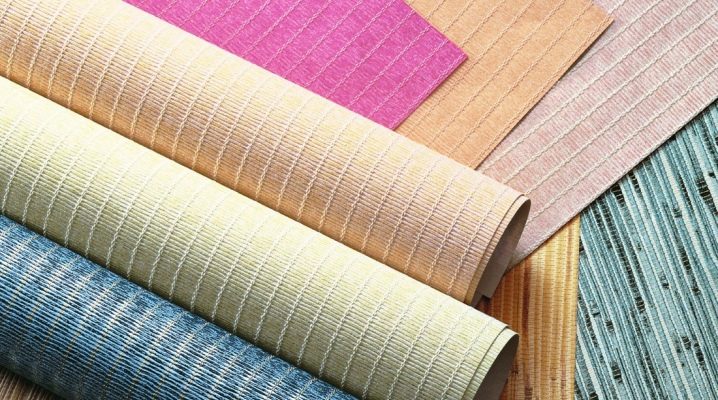
A few years ago, residents of a large country were forced to be content with the wallpapers that were offered to them in hardware and hardware stores. But as time went on, production technologies changed, and modern paper was replaced by modern ones. People have the opportunity to paint the wallpaper in a color suitable for the design.
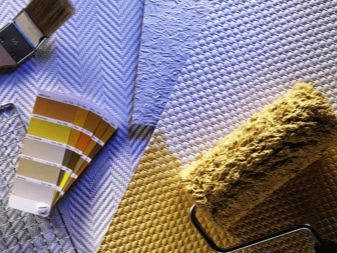

What can you paint?
Modern wallpaper production technology involves the use of high quality materials.
But first, it should be noted that ordinary paper wallpaper should not be painted.
No special relief is applied to plain wallpaper. Even if the paper wallpaper is painted, firstly, from the outside it will not look aesthetically pleasing, and secondly, the paper will swell and fall off after a short time.
There are three types of paintable wallpaper:
- vinyl;
- glass wallpaper;
- non-woven.

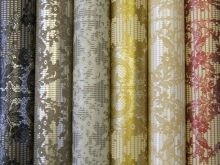
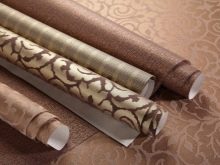
Vinyl wallpaper is made of both paper and non-woven material. They can be dyed up to ten times. They are used in any premises, for kitchens and children's rooms it is best to select washable ones with a pattern.
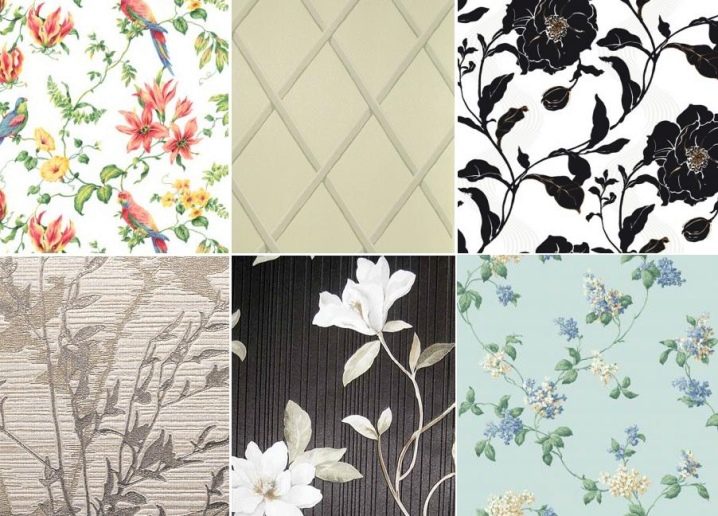
Glass fiber is made from natural materials - dolomite, lime and quartz sand. Another component included in the composition is soda. All these components are applied to a paper base. There are two types of glass wallpaper: single-layer and double-layer. They can withstand more than ten stains. Wear-resistant, so they can decorate the room for several years. They are washed with a regular brush and water. Most often, they are pasted over government and office premises.
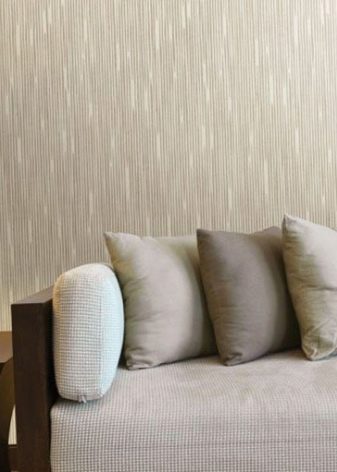
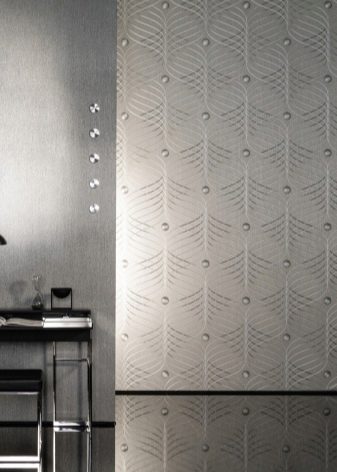
Non-woven wallpaper is highly durable. They are based on non-woven material - a material that is made from compressed fibers. Foamed vinyl is applied on top, resulting in various patterns. Coloring on a non-woven base lasts for more than one year.
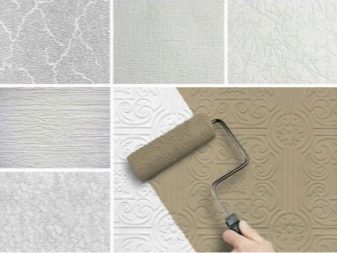
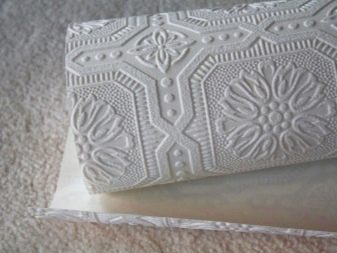
It should be noted that on the market you can also find liquid wallpaper for painting. Liquid wallpaper is a relative novelty among building materials. It is more correct to refer them to decorative plaster. On sale, they are found in the form of dry mixtures and diluted concentrates. Dry liquid wallpaper must be diluted in water before application. They consist of safe substances - PVA glue, coloring pigment and a base - cellulose flakes. Depending on the colors, silk, dust and glitter can be added to the composition.
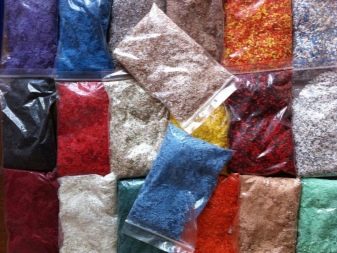
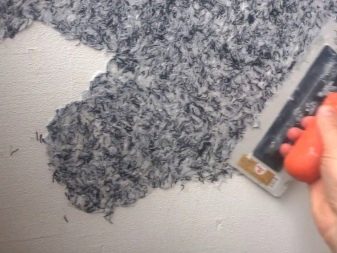
Among the advantages of liquid wallpaper is the fact that they hide the unevenness of the walls, cracks and chips. Mold does not form under them, microorganisms do not colonize them. They do not crack or peel off like wallpaper rolls. They do not have butt seams and provide good thermal insulation. Defective spots are replaced in a few minutes, no need to re-glue the whole room.

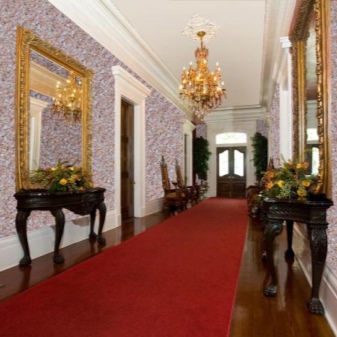
Advantages and disadvantages
As noted earlier, liquid wallpaper does not peel off after painting. The thing is that a diluted solution is applied to the wall, while the drawing can be made with your own hands. A layer of liquid wallpaper contributes to noise reduction, which means that extraneous noise from the entrance or street will not enter the room. The ease of the procedure for applying liquid wallpaper allows any adult to make repairs, this does not require special skills and knowledge.

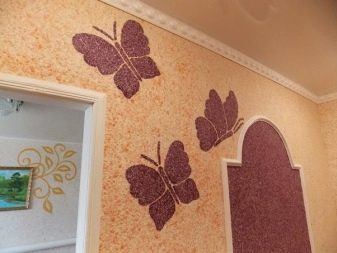
Liquid wallpaper has its drawbacks - it can fade under the influence of sunlight, cotton absorbs odors, so you should not decorate the walls with this building material in the kitchen.
The advantages of vinyl, non-woven and fiberglass wallpapers were partially described in the previous section, and of the minuses, one can only note their high cost. Unfortunately, even cosmetic repairs cost a pretty penny.
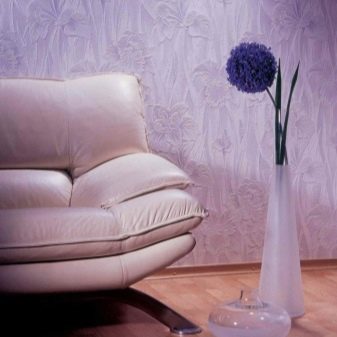
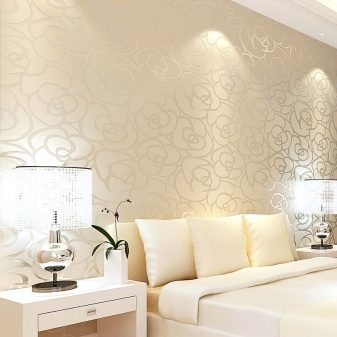
When is the best time to paint?
After gluing the wallpaper, plasterers are advised to wait about two days, during which time the wallpaper glue will dry completely, and the wallpaper will hold tight. If you apply paint on the same day after gluing the wallpaper, then there is a high probability of the appearance of marks and stains.
You should be careful when buying non-woven wallpaper, some of which are not intended for painting.
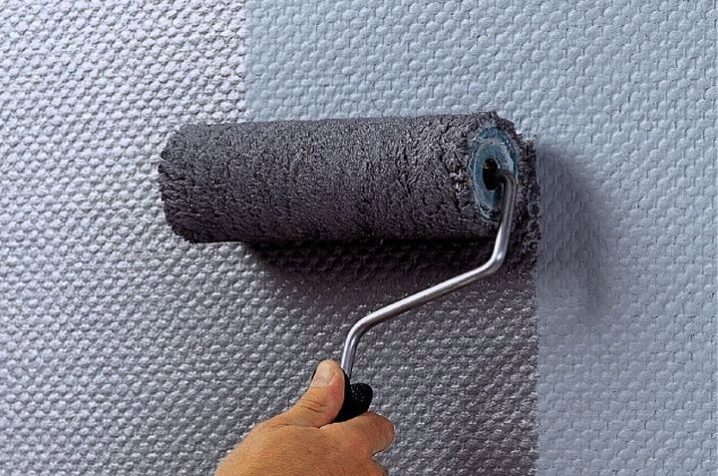
How to choose paint?
High-quality paints will also have to be matched to good wallpaper. It is not worth saving, since questionable products can negatively affect the state of health. If there are allergy sufferers or small children in the family, it is advisable that they were not in the room at the time of the renovation.
Today, paints are most often used:
- alkyd;
- acrylic;
- water-dispersive.


Alkyd paints are bought for utility rooms - basements, storage rooms. These paints can harm human and animal health. The oils and resins that make up them can disable even a healthy adult man. But they have a number of advantages. They have a high saturation, are indifferent to humidity, do not deteriorate under the influence of ultraviolet radiation.
The antifungal components included in their composition do not allow the development of mold on the wallpaper.
Their service life is only five years, they are highly flammable, so it is undesirable to apply them near an open fire. The cost of acrylic paints is very low.
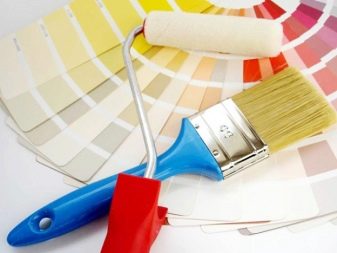
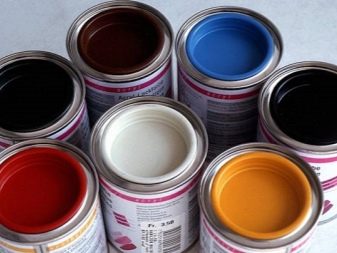
In the composition of water-dispersion paints there are no harmful substances, therefore they are suitable for city apartments. A huge selection of colors will allow you to match the color to any interior.
Latex paint on a water-dispersion acrylic base is mainly used for non-woven embossed wallpaper and glass wallpaper. It dries up in a few hours and has no specific odors. Recommended for use in bedrooms, kitchens and living rooms, but cannot be used in bathrooms.
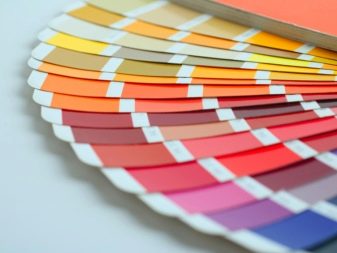
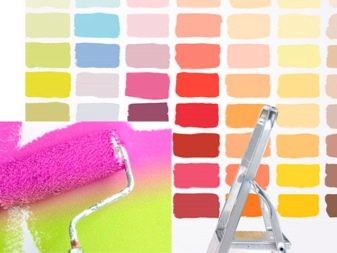
Water-based latex paint will last for years. Its elasticity is achieved through specially formulated substances. In the store, it is found in a universal white color, other colors are obtained by diluting it immediately before application.
Acrylic paints are suitable for city apartments, country houses and office premises. Such paints are bought even for kindergartens. There are no harmful chemicals in their composition, but the price, respectively, of acrylic paints is high.
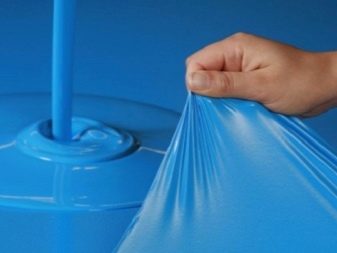
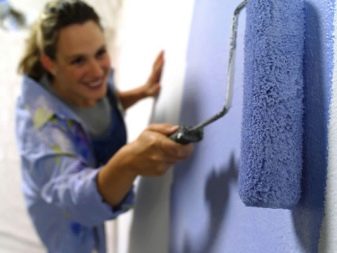
Water-based acrylic paint for non-woven wallpaper. It stands out among competitors for its rich colors that do not fade over the years of operation. It can be applied both to paper wallpapers and glass wallpapers.
Acrylic paints are odorless, do not cover the wallpaper with a film, due to which they "breathe". And they dry in just one day.
Water-based paint does not contain harmful chemical components, therefore it is used in residential premises for commercial and domestic purposes. After painting, the wallpaper is moisture resistant, can be washed, and does not emit odor. Water-based paint can be used to paint kitchens, bathrooms and swimming pools thanks to the silicone base.
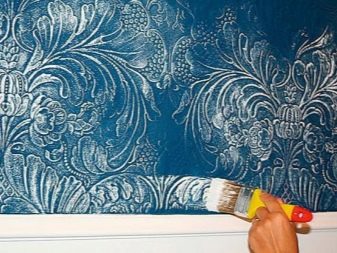
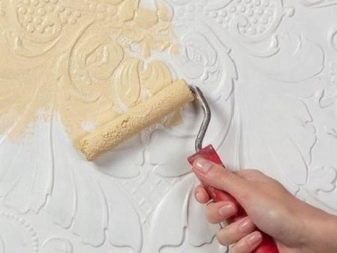
As for liquid wallpaper, their mixtures have certain dyes in advance. Some experts recommend painting the wall before applying liquid wallpaper. For this, oil paint is used. In this case, the spots do not appear, the saturation of the shades increases, and the surface is leveled.To make the textured wall stand out against the main background, there is a design solution: before applying liquid wallpaper, paint the walls in bright, exotic colors.
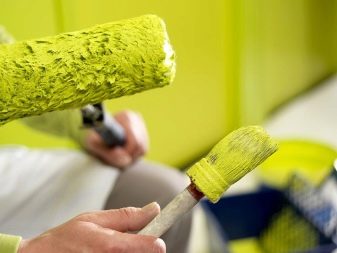

Remember that in cases where the walls are already painted in the room, for example, magnetic paint was used, before the next step - wallpapering, you need to "highlight" this place. Otherwise, unpleasant stains will appear under the wallpaper. To maintain the magnetization effect, the paint must be applied about five times, and the wallpaper must not be very thick. The next layer of paint is applied only after the previous one has dried. Therefore, liquid wallpaper is best suited for magnetic paint.
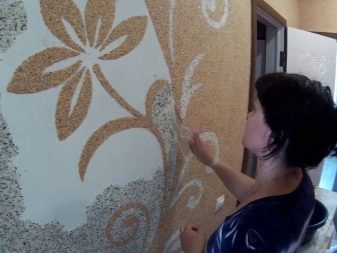

Now let's talk a little about the features of paints. If the paint has no gloss, it is matte. It is best applied in larger rooms. Semi-matte looks great in bedrooms, and glossy paint looks great in rooms where sunlight will play up the interior.
Semi-gloss paint is well cleaned, it is more advisable to apply it to kitchen walls, however, like satin paint, it is also moisture resistant.
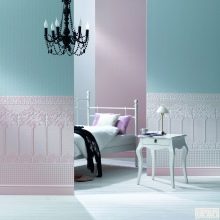
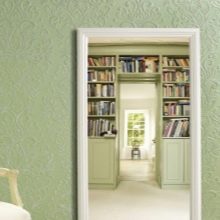
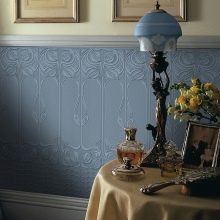
Using a water-based varnish, you can increase the mechanical strength of the wallpaper and its water resistance. But it is worth considering the disadvantages of this event. Shine will "reveal" all the irregularities, the process itself is laborious, you need to be patient. Varnish contributes to a change in the main shade, but at the same time such wallpapers are well washed.
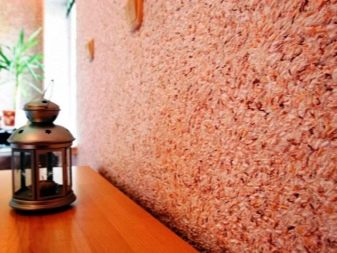
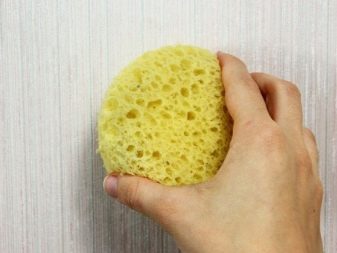
Consumption
The consumption of paint will primarily depend on the varieties of wallpaper, and secondly, on the varieties of the paint itself. Paper wallpaper, unlike glass wallpaper, absorbs more moisture, which means that much more paint will be required. On average, a liter of acrylic paint is enough for 5 square meters. m. But, if you apply the paint in several layers, this will lead to an increase in consumption.
Before you go to the construction market, you need to make measurements. Balcony blocks and doorways do not need to be considered. If furniture is installed in the room, for example, a wall or wardrobe, which is not planned to be rearranged, then the wall behind this furniture need not be painted - this will significantly save money.

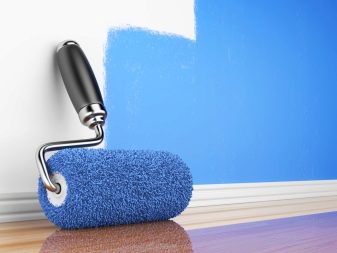
Tools and materials
It is best to use a roller to apply paint to the wallpaper, this will save time on work and reduce paint consumption. There are several types of rollers, fur and foam rubber are suitable directly for painting. Velor and polyacrylic rollers are used for other tasks.
Masking tape is required to apply various stripes and patterns, thanks to it there will be no spikes, and the pattern will be even. By the way, you need to remove it very carefully so as not to tear it off along with the paint.
A roller is not suitable for painting small parts, so it is best to use a brush. Brushes, like rollers, must be wrung out thoroughly before application to avoid uneven layers.
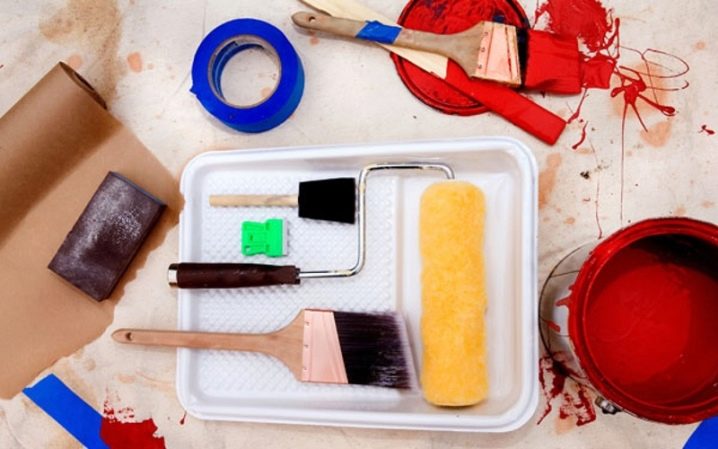
The paint will have to be diluted in an unnecessary container - in an old plastic bucket or a large container of mayonnaise. After all, after the completion of all work, this container will need to be thrown out, unfortunately, it is almost impossible to wash it.
A plastic bath is a specially designed device for painting walls. A small amount of paint is poured into the niche, and the upper part of the tray allows you to squeeze out the excess.
For some cases, varnish and color may be needed. It has already been written about varnish earlier, and with the help of a color scheme, you can create various colors. Kohler is most suitable for non-woven wallpaper. By adding a color scheme with the desired color to the white paint, you can modify the interior beyond recognition.

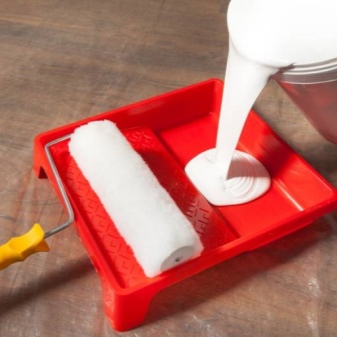
Using a stencil, you can apply special designs, patterns and inscriptions to the wallpaper. "Pictures" are obtained at a highly artistic level even by a person who does not have professional education in this area.
It is more advisable to use a spray gun for painting large rooms, this saves both consumption and the time spent on work.
With this tool it is easier to make the surface uniform.

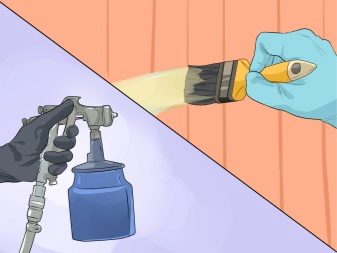
Technology
First of all, it is advisable to prime the walls, and only then glue the wallpaper. Primed walls will allow the wallpaper to hold for a long time, and in addition, the primer will also level the walls. An acrylic or PVA glue-based primer is most suitable for residential premises.
When all the tools are prepared, and the wallpaper is already glued, the next stage of repair is ahead - painting them.
Preparing wallpaper for painting includes the following steps:
- Removing dust from the surface. For this, a vacuum cleaner or a dry cotton rag, napkin is best suited.
- Removing glue residues. Especially glue can manifest itself at the joints.
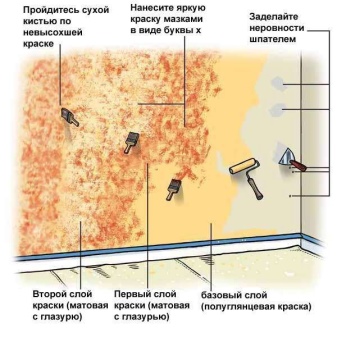
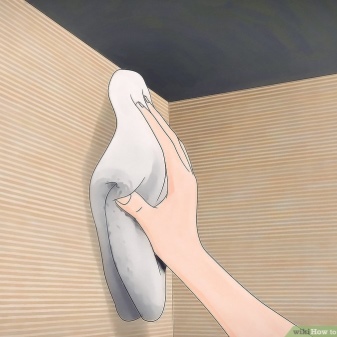
It is advisable to lay cellophane or plastic wrap on the floor. If you use old newspapers, they can absorb excess paint, and the laminate or linoleum will be stained.
All furniture, household appliances and electronics must be removed from the territory of the room. Batteries, ventilation grilles and window sills must be protected from paint. They are pasted over with masking tape and baseboards.
Correct painting of old and "freshly pasted" wallpaper on the wall with a roller with your own hands begins with the choice of a tool. It should be remembered that the best paint effect will be obtained when using a roller with a long nap. Such a roller reaches even the most inaccessible places of the decorative layer.
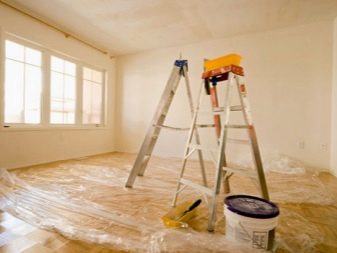
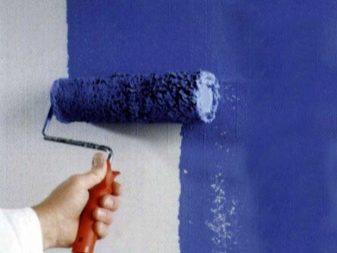
The foam rollers can be used to remove excess paint from the "tops" of the layer. They are not suitable for painting directly, they will leave bubbles behind. A velor roller can be used for the same purposes.
It is more expedient to make a test one before the main painting. For this, less noticeable sections of the wall are selected. You can thus practice the application technique, strength and uniformity.
Water-dispersion paint is diluted with a small amount of water, while it becomes thinner. This paint is easiest to apply to wallpaper, and consumption is also reduced.
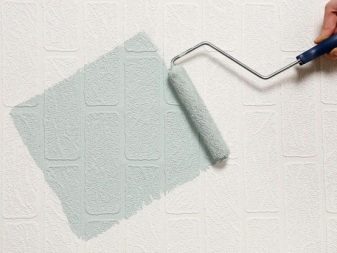
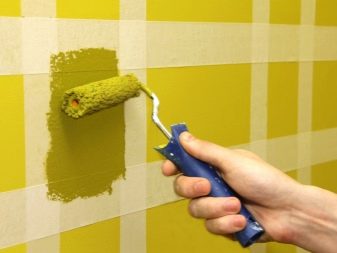
First, all the corners, joints between the walls and the ceiling or floor are passed with a brush, and then the remaining part is painted over with a roller without rest. It is not necessary to squeeze the roller, the movements should be light and fast. The first layer must be completed before the paint is completely dry, otherwise the transitions and joints will be visible to the eye.
Two layers of paint should be applied to textured wallpaper. The second coat must be undiluted. The texture helps to hide the unevenness of the walls and poor-quality painting, so it should not be broken. No friction, just light paint on the wallpaper.
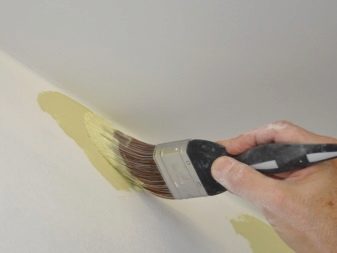
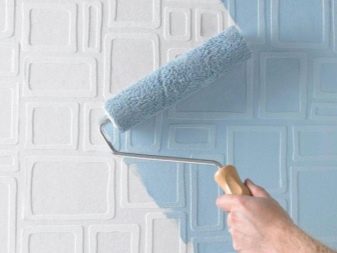
Before applying paint, experts recommend stirring it with a stick or a construction mixer. The paint is uniform, no lumps remain. Alternatively, you can use a screwdriver with a whisk.
If you work together, then you need to start from the corners. Use a brush at the locations of sockets and switches. Remember that if you apply paint to an already painted part, then a double layer will form, and later on, these are spots.
The roller needs to be renewed periodically: either take out the unused one, or remove excess nap from the old one. For this, soapy water is used, the result is fixed in clean water.
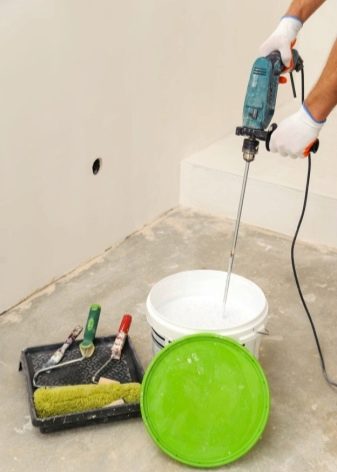

The roller is evenly wetted with chaotic movements along the mesh of the plastic tray, excess paint remains in the tray, and not on the wall. You need to roll it out until the roller is completely impregnated. If this is not done, unpainted parts will form on the wall. This procedure must be repeated constantly with a new addition of paint, after a while the process will be adjusted and there will be no problems with this.
Painters came up with a special technique for applying paint - W-shaped. A letter is drawn, and then it is painted over and so you need to continue from one corner to another. The main thing is to apply without streaks.But for simplicity, it is sufficient to apply paint with a roller from the ceiling to the floor.
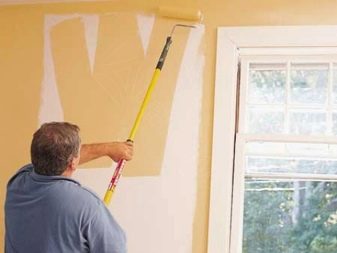
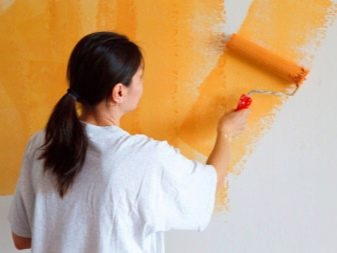
If the humidity in the room is increased, then the drying process of the paint can be slowed down. Thanks to this, painting can be carried out in a longer time.
In many cases, tinting is required. By adding the desired tube with color scheme to the white paint, we achieve various color solutions. Do not neglect the instructions. If you overdo it, you can completely ruin the shade or complicate the repetition process for yourself.
By the way, the desired shades can be ordered in specialized stores. Thus, a can with a new paint will always correspond to the previous one, since the dilution of paint with color is carried out according to special factory technologies, and not "by eye".
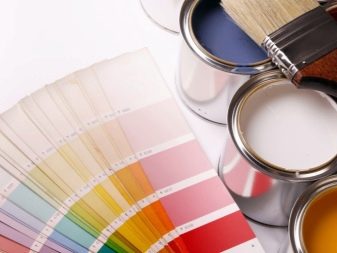

Non-woven wallpaper with a complex texture can be painted from the inside, allowing the rolls to be saturated with paint. The drawing itself will not be painted and will remain in its original color. In the future, it can be painted in any color with a brush. Conversely, you can paint directly the embossed pattern using an ordinary kitchen sponge. Light taps achieve this effect.
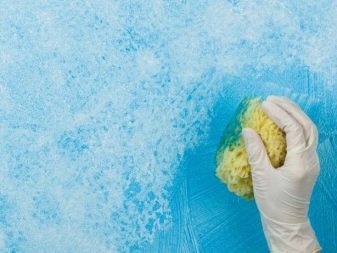
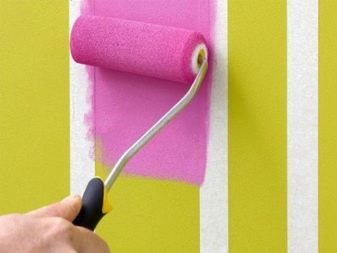
Painting of wallpaper glued to the ceiling is carried out using a stepladder and a roller with a large handle. By the way, you can use a spray gun for ceiling work. Ceiling glass wallpaper is the easiest to paint. All work begins from the corners, and then the remaining surface is painted with a roller. It is better to apply paint in two layers, in the first case - parallel to the window, in the second - across.
Although liquid wallpaper can be "freshened up" using a can of paint, but after that the wall will become smooth. Its texture will be lost. It will no longer be possible to partially remove the material from the wall, only final dismantling is possible.

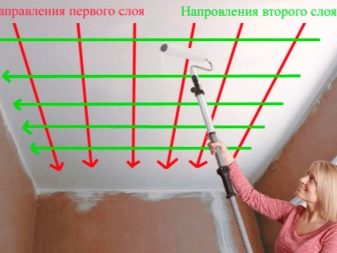
We paint in two colors
Not many people decide to paint a bedroom or living room in a combination. Some are accustomed to universal colors, others are afraid to ruin the interior with their own hands. And besides, no one will return money for mistakes made.
But at the same time, many design solutions provide for the combination of various colors in the room. This can be achieved either by pasting with different wallpapers, or by painting them in different color shades.
Remember that today special methods of combination have been developed.
You can combine:
- colors similar in color;
- making gradient transitions;
- experimenting with different palettes.

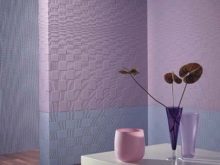
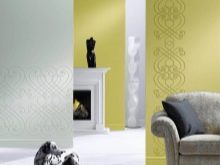
To hide the transitions, special design solutions have been invented. One of them is molding. Moldings are made from safe polymers, they are easily attached not only to the ceiling, but also to the walls. It is more expedient to use wooden or plaster molding in rooms where wood furniture predominates most of all - these can be bedrooms or offices. Polyurethane moldings are moisture resistant and should be installed in kitchens or bathrooms. All moldings are attached to the walls with special glue.
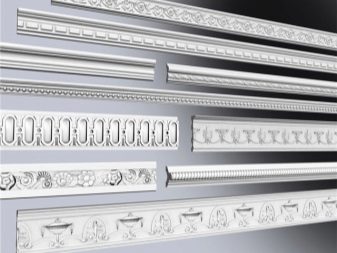
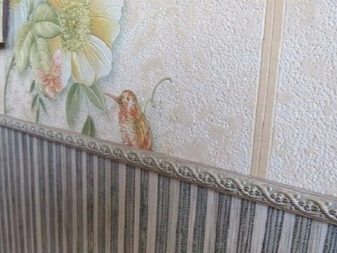
Borders, planks and slats are popular in the design environment - they can be made from both natural and artificial materials. The choice is due only to the design of the premises and the financial situation of the customer.
But most often, masking tape is used for ordinary apartments. It is easily glued and easily dismantled after painting. Masking tape costs little money, is very durable, it can be used with a wide range of temperatures from heat to searing frost.
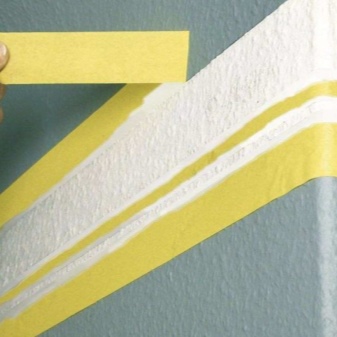
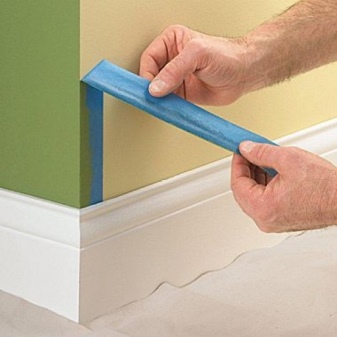
Let us dwell in more detail on the combined methods of painting wallpaper:
- The most challenging is the method called "Accent wall"... With this method, not half of the wall is painted in one color, but the other in another. Here we are talking about painting three walls in one color, and the fourth in a different color. Or this method is used for the ornamental selection of protrusions - fireplaces, chimneys and stoves.
- Horizontal division most often found in city apartments, especially in cases where the lower part of the wall is stucco. The division can be either in the center or with a significant advantage. It is customary to decorate the transition with molding.
If the molding is not provided by the design, then the transition should be performed using masking tape, but it should be removed within an hour after painting.
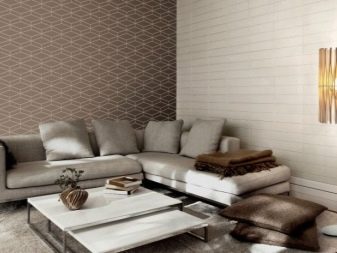
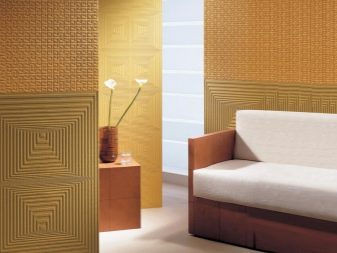
- In children's rooms or in rooms intended for children, it is often done inserts from geometric shapes. First, the entire wall is painted with the selected color and the figures are marked with the help of masking tape. The second layer, which will differ in color, is applied after the first one has completely dried.
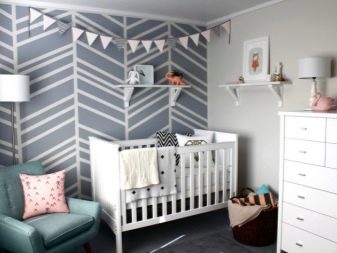
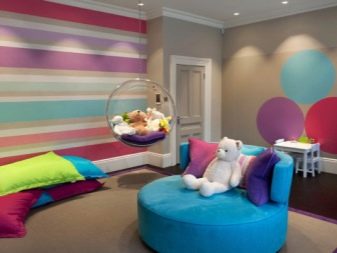
- It was popular a few decades ago gradient coloring method walls. Today, the fashion for the gradient has returned. You can paint each wall a different color or go from dark to light. In the second case, the wall is first painted in one color, and then part of it is shaded.
- Stripes, diamonds and polka dots are used less often, for their application you can use masking tape or a stencil.


How much can you repaint?
Unfortunately, it often happens that after wallpapering in the room, they need to be repainted in a different color. Let's say you didn't like the color or the interior has changed. Or maybe, after a certain time, the previous color just starts to get boring. A reasonable question arises whether it is possible to repaint the wallpaper and how many times it can be repainted.
First, I would like to note that repainting is a popular trend today.
Gone are the days when redecorating meant the obligatory re-pasting of wallpaper. The furniture had to be taken out, the old wallpaper had to be torn off, the new ones had to be glued. It took a lot of time and effort.
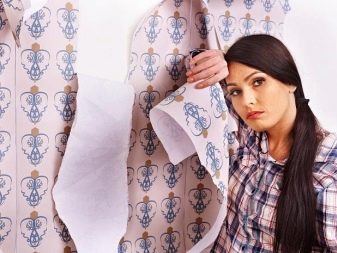
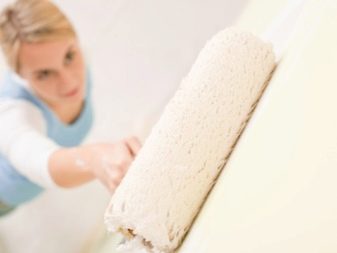
Today you can only repaint a certain section of the wall in the color you like, and that's it - the repair is over.
Manufacturers have taken care of their customers and produce textured wallpaper, the protrusion of which is sufficient to carry out painting work at least five times. Until the drawing is flush with the paint. Usually the quantity is indicated on the package, there are specimens intended for re-staining more than ten times.
But you won't be able to save money in this case.
Remember that the most common paper wallpaper swells and rolls down on the second painting.

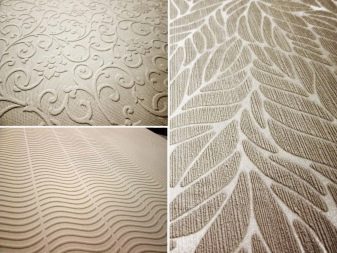
It is also important what kind of glue they were attached to the wall. If cheap glue was used, then after the wallpaper “gains weight”, it will slide off the wall under its own weight.
It should be borne in mind that matte paints clog the picture, in contrast to glossy ones, which, on the contrary, emphasize it. It is advisable to use a water-based paint, it does not create crusts.
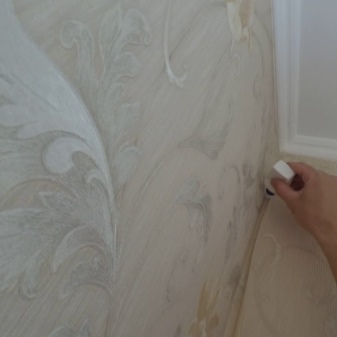

When repainting, you can experiment with the color scheme, for example, a combination of dark blue colors with white paint - you get a pastel color. And when mixing yellow and blue paint, a green tint comes out. If you mix yellow and red - orange.
Bright or color combinations are obtained by mixing green and red colors with white paint. You can experiment with your children, the main thing is not to forget what was mixed with what, in order to repeat this color in the future.
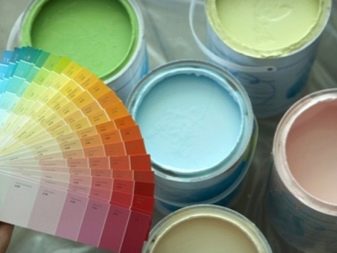
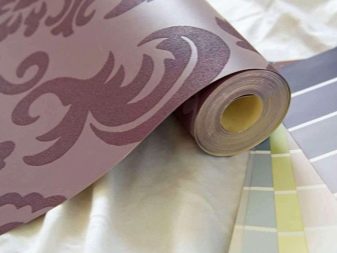
Interior design options
Any city apartment starts with a corridor. Even if the guests come very rarely, the postman, the person checking the meter readings, or the social worker will ring the doorbell at least once a month. Therefore, coziness should be created in the hallway, and wallpaper plays a very important role in this.
From a design point of view in the corridor it is best to use paint in light colors, while the room will not look like a closet. Wall lamps and a glossy floor will complete the composition.

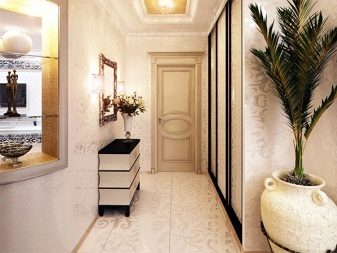
The second most important, and therefore no less important is in the apartment living room... Here guests and households spend most of their time. They rest, have tea and spend the night.Therefore, this room needs a combination of warm, soothing colors.If the living room is dominated by a predominantly white color - furniture, household appliances and electronics, then it is more advisable to paint the wallpaper in light shades.
In studio apartments experts advise to maintain a single design of the kitchen and living room. This combination visually expands the room.
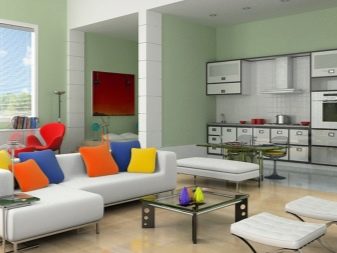
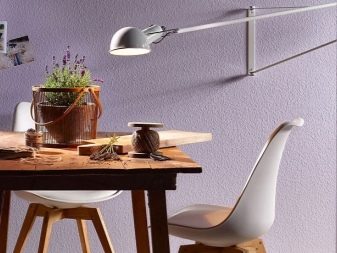
- Concerning kitchen, then in this room it is best to glue washable wallpaper. Even after heavy contamination with droplets of grease or smoke, it is very easy to return them to their original form. And the paint should be used one that does not absorb unnecessary odors.
- Bedroom - this is a secluded room, people are in it mainly only at night. If a married couple likes to sleep before lunch, it is best to give preference to dark shades. And if - to get up at dawn - light. It is a well-known fact: dark colors without gloss absorb light.
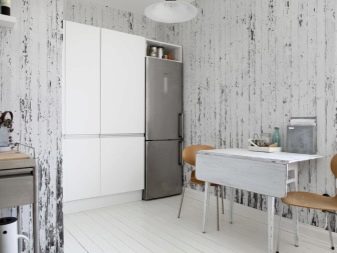
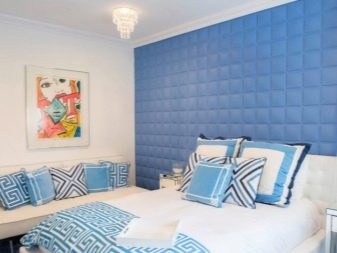
- Original children's room stands out from the background of the entire apartment. Such a room is not ashamed to show both relatives and strangers. Children in such a room will always find something to occupy themselves with in the daytime, and calmly fall asleep in the evening. Decorative painting in the apartment brings a certain charm. With its help, you can emphasize the design feature and hide defects and irregularities in the walls.
- In the old days about sticking wallpaper In bathroom, you could not even dream. The wallpaper itself did not hold up in this humid room, let alone paint it. They turned yellow, fell off after a short time, but, worst of all, a fungus could form under them. And it is very difficult to get it out.
In today's high-tech age, manufacturers sell high-quality wallpapers and special paints for rooms with high humidity. You can paint the bathroom blue out of habit, or you can go for an experiment and paint in a combined way.


- In a country house, especially on the upper floors, wallpaper can be glued, including on the ceiling. Such a transition visually raises the height of the room, hides uneven joints and plays up unsightly corners.
- In office or municipal institutionsusing paintable wallpaper, you can significantly save on subsequent repairs.
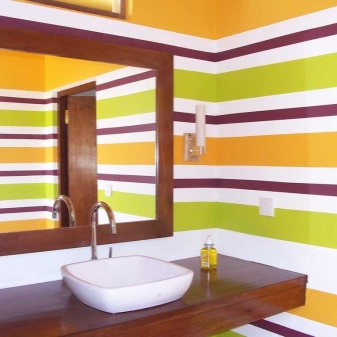

The times when you had to re-glue the wallpaper every two years have sunk into oblivion. Today it is enough to glue the wallpaper for painting once, and you can change their color as many times as you like. At least five, at least ten. The main thing is just to remember that for this you need to buy high-quality building materials.
For information on how to paint the wallpaper correctly, see the next video.













Interesting!
Dulux has a special paint for wallpaper, we used it on plain wallpaper - very convenient.
The comment was sent successfully.